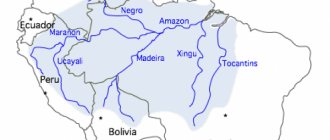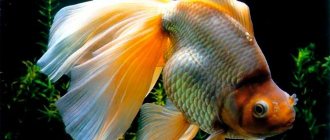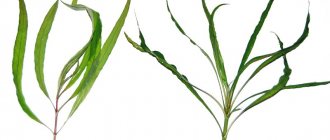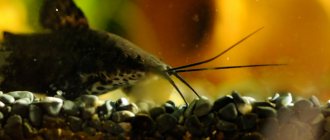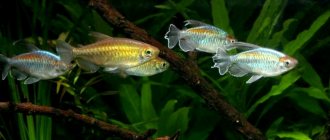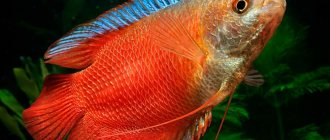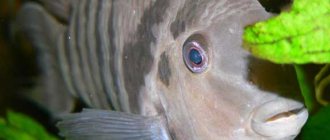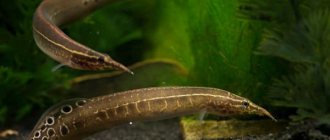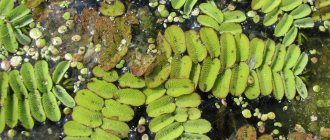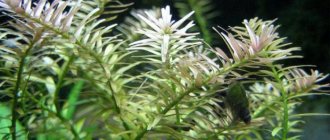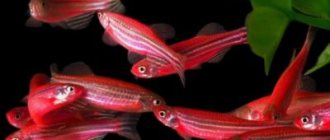Ornatus, a small schooling fish belonging to the characin family, has become a favorite among both beginners and experienced aquarists. Ornathus are unpretentious in their maintenance, unusual in behavior, and peaceful. Due to their unusual appearance, these fish are also known as “phantoms”.
Description
The shape of the ornathus is typical of some large tetras, such as the red-spotted tetra. In a home aquarium, Ornathus usually reaches a length of 5 cm, very rarely it grows to 7.5 cm. It lives for about 3-5 years.
Ornathus vulgaris Pink tetra
In color, Ornathus vulgare is very similar to its closest relative, the roseate tetra, and the differences are very subtle. Both fish are pink in color, close to the color of deep sea salmon, although Ornathus is a more transparent tetra. Both fish have dark red markings on their fins. The ornatus has white markings on the dorsal and pelvic fins called a "white tip", while the roseate tetra has a black marking on the dorsal fin called a "black flag" and sometimes also has white fin tips. "Black flag" can also sometimes be found in Ornathus.
Briefly about other types
There are also several varieties of the fish in question.
So, there is Ornathus whitefin. A very unpretentious fish that easily gets along with other non-aggressive species. Ornatus whitefin can live in a 10-liter aquarium (in pairs), but aquariums from 80 liters are still more acceptable. All issues of maintenance and breeding are similar to the species Ornathus vulgaris and will be discussed below.
There is also Julidochromis ornathus. But this fish belongs to a completely different family. Therefore, it is necessary to maintain Julidochromis ornatus taking into account completely different rules and features.
Finally, you can also hear about such a fish as Elongatus ornatus (or pseudotropheus). This pseudotropheus is also not related to Ornathus vulgaris. Pseudotropheus is a cichlid. To care for this fish, you need to know all the rules, due to which the pseudotropheus will feel comfortable.
Return to content
Maintenance and care
Ornatus, like the pink tetra, are quite hardy aquarium fish, but they are recommended to be kept by aquarists with some experience. These fish require stability and do not tolerate sudden changes in housing parameters, although captive-bred fish are much more tolerant.
It is recommended to keep Ornathus in a group of six or more fish, and for this purpose an aquarium with a volume of 55-75 liters is preferable. White-finned tetras prefer water with low currents, so make sure your filters won't disturb them. In nature, Ornathus live in waters flowing under a dense forest canopy, so the aquarium should be dimly lit.
The aquarium should have live plants densely planted at the back and sides, as well as an open space for swimming in the front. It is better to use river sand as soil. If you add peat granules as a filter media to your filter, your fish will thank you as it will help mimic the “black water” they live in in nature. Add a few dry leaves to the aquarium, you can use alder or oak, as well as boiled alder cones - this will also help create a natural habitat. An excellent decoration for an aquarium will be driftwood and roots, which create shelter and allow the fish to feel comfortable.
Content options:
Temperature : 22 - 28 ° C Dilution temperature : 24 - 26 ° C pH : 6.6-7.8 Total hardness : 3 - 12 dGH
The water in an ornathus aquarium must be stable and clean, but this does not eliminate the need for maintenance. In order to avoid the buildup of organic substances in the aquarium, such as nitrates and phosphates, it is necessary to do regular water changes, especially if you have a very large population.
Every two weeks, change 25 - 50% of the volume of water in the aquarium, and be sure to “vacuum” the soil with a siphon to remove debris accumulated at the bottom.
Ornathus Black
Ornatus Black (scientific Hyphessobrycon megalopterus) or Black Phantom Tetra has a standard body and fin shape for Tetras. Their body itself is oval, laterally compressed and has a transparent brown color.
Near the operculum they have a black spot with a green or silver outline on the sides of their body. The tail of these Ornathus is usually completely black, or, like the fins, it is transparent at the base and black towards the end. Females are usually more brightly colored than males.
Moreover, when male Black Ornathus are ready to mate or while defending their territory from other males, they may acquire a darker color.
Like other Tetras, Black Ornathus prefer to live in schools. Experts advise keeping them in groups of 6 or more. Each fish has its place in the hierarchy of the school.
Male Black Ornathus may fight with each other, but this usually does not result in any significant damage to them. They thrive in multi-species aquariums that do not contain large or overly aggressive fish.
Most of the time they occupy the middle and lower water layers of the aquarium.
Black Ornathus are quite good eaters, so feeding them should not cause any problems. The secret of their excellent health and bright colors is providing them with high quality food and a varied diet.
If you plan to breed Black Ornathus, then you will have to select food for them even more carefully. In this case, the fish must be given high-quality feed, consisting mainly of feed flakes. Also, future parents of Black Ornathus must be periodically fed with live or frozen food.
Compatibility
In nature, ornathus are found in compact groups of up to 50 fish in a group, but in an aquarium it is believed that there should be at least 6 individuals in a school. Tetras feel more comfortable and calm in groups. Pink tetra, black thorn, white thorn, and red-spotted tetra are also suitable for creating a group.
Noisy neighbors in the aquarium should be avoided - they will irritate the ornathus, the fish will be in constant stress (compressed fins are a characteristic feature of this condition). Ornatus vulgaris is easily frightened by loud noises, as well as excessive movement near the aquarium, so you need to install the container in a quiet place.
FEEDING
For the aquarium fish Ornatus vulgaris, you need fairly high-quality food. They need a nutritious, vitamin-rich diet, so high-quality food should make up 60-80% of feeding. They prefer live food, but can also eat tender plants. You need to feed them two to three times a day, with live food (bloodworms, tubifex, daphnia) or high-quality artificial ones.
BEHAVIOR
The description of Ornatus suggests that this fish is peaceful. Its disposition is similar to neons, rasboras, and guppies. Despite the fact that it is considered a schooling fish, under satisfactory conditions without stress, phantoms swim on their own. They gather in a group only when there is danger or in the presence of an irritating factor.
Ideal neighbors for ornathus are the phantoms themselves and most peaceful small catfish. In addition, tetras, platies, pulcheras, and swordtails are suitable for keeping together.
Large predators, small predators, and fish that are too fast and fussy are not suitable. They pose a threat to the moral and physical existence of ornathus.
Phantoms
Night. In a dark room there is a densely populated 100-liter Dutch-type aquarium. Black shadows slowly move in it like phantoms. In one of the corners of the reservoir, several red fish are intently exploring the bottom in search of food. Suddenly a school of pale pink fish swims out of the plants and mixes with the black ones.
Suddenly they all decide to visit the corner where the fish the color of a dying fire continue their research activities. The aquarium is calm. There is a wonderful harmony of smooth movements and contrasting colors here - pink reconciles black with red. Beautiful, like in a fairy tale. For a while you forget about utility bills.
Dear reader, this is a real picture. With a little effort you can turn it into reality. It is enough to place phantoms in your pond - this is the name of the fish from the “fairytale” aquarium described above.
Phantoms (Russian hobbyists often call these fish Ornathus) (genus Megalamphodus) are represented by Latin American characinids with a wide range, covering territories from Bolivia to Trinidad. Black (Megalamphodus megalopterus Eigenmann, 1915) occurs widely in the Rio Guapore basin.
Red (Megalamphodus sweglesi Gery, 1961) is distributed in the Rio Meta and its tributaries. This area is particularly rich in characins; in particular, black neon, peruvianus, loretoensis, meta and others are not uncommon here.
The pink phantom (Megalamphodus roseus Gery, 1960) entered aquariums later than others and is still the object of constant search for many European hobbyists. In nature, it is distributed in the system of tributaries of the Rio Maroni.
In reality, the genus of phantoms includes more than ten described species.
The only exception is the endemic species - the Trinidad phantom Megalamphodus axelrodi. It was discovered by Dr. Axelrod in the streams flowing among the banana plantations of the island of Trinidad, and was identified by him as Aphiocharax axelrodi. It was later assigned to the genus Megalamphodus. A photograph of this fish is occasionally found in encyclopedic publications.
in particular in the “Aquarien Atlas” of the German publishing house “Mergus”, authors A. Baensch and Dr. R. Riehl. I came across a successful photograph in the French magazine “Aquaria”. In Europe, this species was bred by the Czech aquarist S. Frank and was given the name “red pristella” by his compatriots due to some similarities with Pristella maxillaris.
In 1998, from Moscow, from the Aquarium World exhibition, I received a pair of adult Megalamphodus sp., which came from Colombia. They were very similar to regular red phantoms, but were duller in color and smaller in size.
The black phantom is 4-5 cm long. The body of the male is dark gray to black, lighter on the abdomen. All fins, with the exception of the pectoral ones, are black. The dorsal fin of the male is high and curved back; in the female it is noticeably lower and shorter.
Particularly impressive is the side black spot of irregular shape, surrounded by a luminous purple edging. The female has a rounded abdomen and red anal, adipose and ventral fins.
In young fish, reddish tones predominate, and sex determination is very difficult.
In the female, this fin is short and rounded, orange to red in color, with a black central zone and a white spot at the end. Females are again slightly plumper than males. It is also almost impossible to determine the sex of young fish.
Therefore, in order not to repent later, it is better to immediately buy a dozen individuals and raise good pairs.
The pink phantom is the smallest. Its length does not exceed 3.5 cm. The lower rear part of the body is pink-red, the rest is pale yellow. The fins are colorless, the anal fin has a milky white edge. The female is much larger than the male, but he is much slimmer. There is a bright black spot in the front of the body.
Phantoms do well in a 50-100 liter aquarium with dense vegetation and open space for swimming. These peaceful fish get along well with all small hifessobrikon (excluding minors and serpas), nannostomus and neons. Chemigrammus are less suitable for them as neighbors: they are too sharp and swift for very calm phantoms.
READ How and what to feed the Pomeranian Spitz - all the features of natural and industrial nutrition
It is advisable to replace 1/4 of the volume of water weekly with tap water that has been standing for a week. The most suitable temperature for keeping phantoms of all types is 23-25°C. Naturally, water aeration is required.
Phantoms are omnivores, but prefer small live food, primarily cyclops. If teenagers are not fed it from an early age (after the first month), then there is no hope of raising, for example, a bright red phantom.
To enhance the red color, I recommend adding TetraMin and Tetra Rubin to the menu.
For those who plan to breed phantoms for amateur purposes, I do not advise feeding future breeders with tubifex. Young fish raised for sale can be given chopped and well-washed tubifex, which has been kept for at least a week in frequently changed water for cleaning.
As is known, in the literal sense, complete disinfection of the tubifex is impossible: when any disinfectants are added to the water, these oligochaetes die.
Phantoms are strong fish that tolerate diseases relatively easily. They also react calmly to changes in the acidity of the water, but there is no need to get carried away with this and overly rely on their endurance.
Like all characins. they are susceptible to ichthyophthyriasis and oodynia. Believed to be parasites. that cause these diseases usually enter the aquarium along with live food caught from water bodies where fish live. Invasion is promoted, in particular, by a sharp drop in temperature.
Due to the dark coloration of the body and fins, damage to black phantom by ichthyophthyriasis is easily recognized at an early stage. This allows you to take prompt action in a timely manner and achieve a positive result relatively easily.
If among your fish you notice individuals with whitened areas of the body (muscle tissue, not epithelium), rest assured, this is plistophorosis or neon disease. Typically, this whitening begins from the caudal peduncle. This disease cannot be treated, so do not ask your friends for advice, but simply throw away the sick fish.
Sexual maturity in megalamphodus occurs after the sixth month of life, and good pairs are formed during the eighth month. For experienced aquarists, breeding phantoms is not a problem. The water parameters are as follows: dGH 1-2°. dKH 1°, pH 6.0-6.5. T=25-27°C.
The ideal volume for breeding is 10 liters per individual, but more compact containers are also suitable. I breed fish in three-liter “neon spawning tanks” with a safety net installed on the bottom and a water level of 1520 cm.
As a rule, phantoms spawn on the third day after being placed in the spawning tank. The coloration of males during the mating season reaches a peak of contrast. By spreading his fins, the male demonstrates all the splendor of his coloring and attracts the female. Ta. pressing its body against it for a moment, it releases 7-12 eggs. Then the cycle repeats.
The activity of producers is gradually decreasing. and at the end of spawning, the pale female hides in the thickets of plants. The mating games of pink phantoms are less spectacular - the male persistently pursues the female throughout the aquarium and knocks out portions of eggs from her with blows to the body.
In the first hours, the eggs have a transparent amber yolk and a colorless shell. As the embryo develops, the yolk acquires a brownish tint and loses transparency. In red and black phantoms, the number of eggs ranges from 50 to 400, depending on the size and degree of maturity of the female. The pink phantom usually lays 20-100 eggs.
Depending on the water temperature, the larvae hatch after 23-30 hours and lie helplessly on the bottom and protective net for some time. Although their bodies are completely transparent, they are easy to spot thanks to their brownish yolk sac.
On the third day, the larvae rise and hang on the walls, on the 4-5th day they begin to swim and look for food. At this point they should be given ciliates or rotifers. If these feeds are not available.
REPRODUCTION
To obtain offspring, the couple needs to be isolated in a small aquarium with rich vegetation and (preferably) a separator net at the bottom to protect the eggs from being eaten and a water level of no more than 15 cm. Water parameters for successful spawning: hardness from 1 to 3 degrees, temperature from 25 up to 28 degrees, pH 5.8-6.5.
To breed ornathus at home, you will need a spawning aquarium with the following parameters:
- Volume 30 l, water level 15-17 cm;
- Temperature 26-28 °C;
- Hardness 1-5 gH;
- Acidity 5.5-6.5 pH;
- There is no artificial lighting; the aquarium must be protected from natural lighting;
- Java moss;
- Mesh on the bottom.
Spawning requires a school of fish in a 1:1 sex ratio. How to determine the sex of Ornathus: usually males have a sharp and large dorsal fin, and sometimes all other fins are larger than those of the female. The female has a more rounded body shape with a prominent abdomen.
Reproduction should begin by adjusting the diet at least two weeks before the expected spawning. Phantoms are switched to live food with a high protein content. Then they are transplanted into a special aquarium, where spawning should begin within 24 hours.
During spawning, the female lays eggs on the leaves of Java moss or on a net through which the eggs fall to the bottom. After spawning, the fish are placed in a common aquarium. The fry are fed live dust, Artemia nauplii, and ciliates, and then switch to starter feed. As the young grow older, they are transferred to adult food, after which the fish can be moved to a common aquarium.
Diseases
Ornathus have a strong immune system, which helps them practically not get sick. Fish are mainly susceptible to bacterial and parasitic infections; they easily tolerate medications added to the water. Diseases of this kind manifest themselves in the appearance of plaque on the body, frayed fins, lethargy, and dull eyes. The sooner treatment is started, the greater the chance of saving the fish’s life.
https://www.youtube.com/watch?v=Xuwjq9EWcQ4
Prevention of diseases consists of timely and complete proper care of the aquarium: cleaning the soil, changing water. Equipment, decor and everything that goes into the aquarium must first be disinfected. Live food should only be purchased clean, from trusted places. Choose high-quality dry food. All new residents must undergo quarantine before being moved into phantoms.

